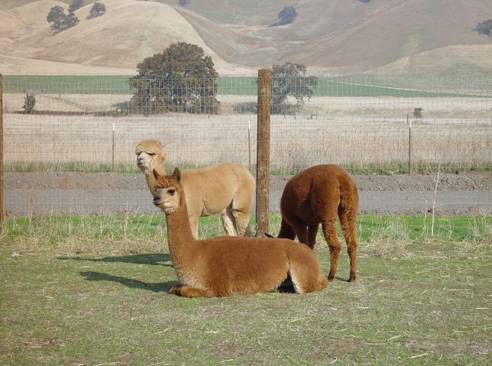About Alpacas


Alpacas are South American Camelids, closely related to the other camelids of South America, the llama, the guanaco, and the vicuna. The native habitat of all of the South American Camelids is the high mountainous plateaus of Chile, Bolivia, and Peru, known collectively as the "altiplano". Alpacas, weighing typically about 150 pounds, are much smaller than their 450 pound llama cousins, so they are not used as pack animals. Instead, they were developed by the Inca Indians over a period of 5000 years solely as a source of luxurious fiber. In fact, the alpaca was so revered by the Incas and their fiber so valued that only Incan royalty was allowed to wear garments made from it! It's not surprising that alpaca fiber was considered so valuable- it is, on a pound-for-pound basis, much warmer than sheep's wool, and it has the soft, silky feel of the finest Cashmere. Like all natural fibers, alpaca comes in several grades, depending on the diameter of the fibers and their softness. The finest grades, often called "baby" and "royal" grades, are so soft they can be worn directly against the skin, without the "prickle" often associated with courser animal fibers.
Importation of alpacas into the United States began in the late 1980s. Since that time, the census of animals in the USA has been growing steadily. The number of alpacas in the USA is easily determined, since all alpacas in this country are registered with a national registry, the ARI (Alpaca Registry, Inc.). Currently, the US herd numbers about 45,000. The gestation period for alpacas is about 11 months, more or less, so one can expect one baby (known as a "cria") per year from each producing female. Alpacas come in a variety of colors, and the color inheritance is, so far, not well understood. So each new cria is like a Christmas present - you never know what you're going to get! One thing, however, is certain: The cria, whatever color he or she is, will be one of the cutest things on Earth. Watching them grow and play is one of life's greatest pleasures for an alpaca breeder.
Compared to most other livestock, alpacas are very easy to care for. An alpaca eats about 1.5 pounds of grass hay per day, so a ton of hay (costing about $100 - $160) will feed an alpaca for over 3 years! In addition to hay, most alpaca owners also feed prepared pellet feeds, as well as mineral supplements and vitamins. Alpacas, having padded feet instead of hooves, are very easy on the land. If hay is used as the primary feed source, one can easily house 10 - 20 alpacas on a single acre of land. Alpacas do not tend to challenge fences, but are content to stay with their herd, so they are easy to contain. In fact, fencing is typically more a matter or keeping out dangerous predators, such as stray dogs and coyotes, rather than keeping the alpacas in. Alpacas are extremely adaptable, and despite having come from a region that gets below freezing nearly every night, they thrive in all climates of the USA. They do, however, require a covered or otherwise sheltered area for protection from the elements, especially from the hot summer sun in the warmer areas of the country.
Alpacas make a variety of sounds, but the most common is a gentle humming. You can hear this gentle humming as they graze, or settle in for the evening. Mothers and crias sometimes communicate to each other with a clicking or clucking sound. The loudest sound alpacas make can best be described as a screech. Many, if not most, alpacas never make this sound, but a few do, particularly if they're extremely frightened or angry. The most unusual sound alpacas make is their alarm call, which varies considerably from animal to animal but is typcially a rather shrill, almost chirping, sound. You'll most likely hear the alarm call when a predator or stray dog comes into the area.
Shearing day comes once a year, typically in the spring before the hot weather arrives, and what a day it is, especially if you're a lover of fine fiber. Each animal will produce from 3 - 10 pounds of prime fiber, and by day's end you'll have had your hands in a veritable mountain of softness. Alpacas come in a wonderful array of colors, ranging from white to black, many shades of brown from a very light fawn color to deep chocolate, with some shades containing red reminiscent of rosewood or mahogany. Some animals are all the same color, while others are varied, with color blends ranging from isolated spots to a completely homogenous blend of different color fibers, as found on alpacas described as "rose gray".
©2007, Cinebar Star Ranch, 4274 State Route 508, Cinebar, WA 98533 - Send Email to CSR - Call us at 360-985-7467